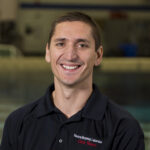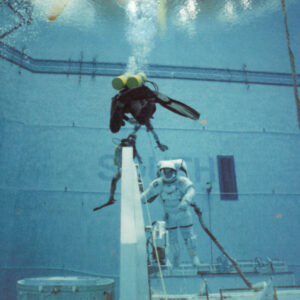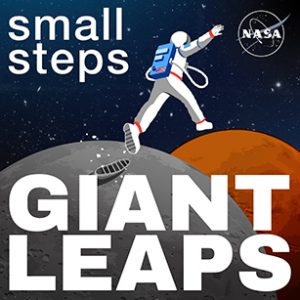NASA Neutral Buoyancy Laboratory Critical Systems Engineer Jim Sarafin discusses training astronauts for spacewalks.
The Neutral Buoyancy Laboratory (NBL) at NASA’s Johnson Space Center is used to prepare crew members for space missions involving spacewalks. NASA team members use the NBL to train astronauts, develop flight procedures, verify hardware compatibility, and refine spacewalk procedures as necessary during flight to ensure mission success.
In this episode of Small Steps, Giant Leaps, you’ll learn about:
- The role of NBL professional divers
- Configuration setup for training astronauts
- NBL support for future lunar missions
Related Resources
Sonny Carter Training Facility: The Neutral Buoyancy Laboratory
Video: NASA’s Neutral Buoyancy Laboratory 360 Tour
Building on a Mission: Neutral Buoyancy Facilities for Spacewalk Training
About – Hubble Servicing Missions
Episode 101: Artemis Missions (Small Steps, Giant Leaps interview with Mike Sarafin)
APPEL Courses:
Creativity and Innovation (APPEL-vC&I)
Human Spaceflight and Mission Design (APPEL-vHSMD)
Earth, Moon, and Mars (APPEL-EMM)

Jim Sarafin
Credit: NASA
Jim Sarafin is a Critical Systems Engineer at the Neutral Buoyancy Laboratory (NBL) at NASA’s Johnson Space Center. Sarafin is responsible for the daily operations, maintenance, and upgrades of the NBL Breathing Gas System and Environmental Control System. He has served as the Project Engineer/Lead for a multitude of NBL system and facility upgrades and integration of the Z-series prototype spacesuit into the NBL. Sarafin has supported crew training at the NBL as a Utility, Safety, Camera, and Reconfiguration Diver for the assembly of the entire International Space Station; space shuttle flights STS-88 through STS-135; Hubble Space Telescope servicing missions; and the Alpha Magnetic Spectrometer. He began his NASA career in 1997 as a Critical Systems Maintenance Technician, performing maintenance and upgrades to a wide range of NBL systems. Sarafin holds an associate degree in automotive technology from State University of New York.
Transcript
Jim Sarafin: You swim down to the crew with your dive team, and you see the spacesuits underwater, and they’re already working on the ISS. And then just the overall vastness of the ISS in itself is just some of the most amazing, unique sites that you ever see.
Everything that they do here at the NBL, they will do in space. So, they’ll know what to do, when to do and how to do it once they get on orbit and perform the actual EVA.
Some of the video footage that you’re seeing while they’re performing the EVAs and you recognize the hardware and you know that this facility and this team has been an integral part of them performing that.
Deana Nunley (Host): Welcome to Small Steps, Giant Leaps, a NASA APPEL Knowledge Services podcast where we tap into project experiences to share best practices, lessons learned and novel ideas.
I’m Deana Nunley.
Spacewalks are essential for current and future space initiatives, and the Neutral Buoyancy Laboratory at NASA’s Johnson Space Center is the foundation for successful spacewalk preparation.
Jim Sarafin, a Critical Systems Engineer at the NBL, has been a diver training astronauts in the huge indoor pool for 25 years, and joins us now.
Jim, welcome to the podcast. Thank you for being our guest.
Sarafin: Hi, Deana. Thanks for having me.
Host: The Neutral Buoyancy Laboratory is often described as one of NASA’s coolest training facilities. Could you tell us about the NBL and what makes it unique?
Sarafin: Yeah, it’s quite an amazing facility. It’s built to train astronauts for spacewalks. It is a large tank, and it is 102 feet wide, 202 feet long. It’s 40 feet deep and it has 6.2 million gallons of chlorinated freshwater in it, and it’s maintained at 86 degrees Fahrenheit. And it’s unique just due to the fact that it’s used exclusively to train crew to perform their EVAs and full-scale International Space Station mock-ups in it. And everything that they do here at the NBL they will do in space. So, they’ll know what to do, when to do and how to do it once they get on orbit and perform the actual EVA.
Host: What’s your role at the NBL?
Sarafin: I am currently in the Critical Systems Engineering Group, and I am responsible for the life support systems that keep the crew members alive and well while they’re in the water. Throughout my years here at the NBL, I’ve also been in the Dive Operations Group, where I actually exclusively just dove with the crew and helped them train to perform all their EVAs and all the aspects that go along with that as you know, which includes the configuration of the mock-ups and set up before and after the crew get in for further respective flights that they’re assigned to.
Host: How did you land a job as a professional diver training astronauts?
Sarafin: Well, it’s not the typical route that one would think. I grew up on a family dairy farm in rural upstate New York. And I as well as my brother Mike, who is now the Artemis Mission Manager, oddly enough, we grew up together milking cows. And he at a very young age knew that he wanted to work for NASA, and he basically had a laser focus from a kid and he took a very straight path to working for NASA and he ended up landing a job with the agency after going to college. And he asked me if I wanted to move down to Houston with him and I, of course, jumped at the opportunity to move to Houston. And we moved down to Houston in 1994.
And Mike got a job as a flight controller pretty early on. And I was working in the automotive industry, and I eventually learned of the job opening here at the Neutral Buoyancy Lab. And I never had NASA in my sights, but I really was excited about the opportunity. And they were doing some major upgrades to accommodate the up-and-coming need for more training, and I was fortunate enough to just be able to apply to the job with my mechanical and electrical background skills. And thankfully, I was fortunate enough to be able to get the job and thankfully, 25 plus years later, I’m still working at the Neutral Buoyancy Laboratory.
Host: You mentioned configurations in the setup. So, what’s involved in setting up different configurations for crew training?
Sarafin: Yeah, so there’s quite a vast array of items that need to be set up. It can start with anything from actually getting the large mock-ups in and out of the water, which it’s a major overtaking. It requires the overhead bridge cranes and big lifts from the high bays and in out of the water in the event that we need to change mock-ups or reconfigure the mock-ups all the way down to some smaller items or medium-sized items that the divers can actually swim down from top side down to the mock-ups and configure them for that mission for the day or whatever specific task that the crew member’s going to be working on.
Host: And these configurations, do they change out pretty quickly? What’s the process there?
Sarafin: Now that the ISS has been assembled for quite some time now, there’s some upgrades. The space station was initially only built for NASA. And now that we have all these other private entities that are coming and docking to the ISS, there will be some different modifications in the wiring harnesses because they’ll need power or data to certain locations. So, we might run some new cabling or even up to a different docking adapter which is in place now. It’s the International Docking Adapter, which SpaceX or Boeing will dock to now when they go to the space station.
Host: So, what kind of team does it take to make all of these changes in the configurations within the pool?
Sarafin: It’s quite a good handful of people. It takes quite a few people on top side to be able to support and assist with getting whatever hardware needs to be in the water configured and to the divers. If it’s larger items, we’ll need crane operators and some other personnel to manage the large mock-ups while they’re getting in and out of the water. I mean, there’s quite a large amount of people in the dive team that exclusively dive and support crew training day in and day out, as well as perform the in-water task to either maintain and/or repair the mock-ups as they need it throughout the duration of the year.
Host: How much time does an NBL diver spend underwater?
Sarafin: That’s a good question. That varies pretty drastically. A lot of that depends just on how long a diver’s been at the NBL throughout their career, and that number varies from — we have one individual, he has over 10,000 hours of dive time here at the facility just due to the fact that he’s exclusively supported Dive Ops for the duration of his career here. And that number can dwindle all the way down to some of our newer divers who only have a few hundred hours while they’re getting trained and signed off for their respective duty stations. Then on top of that, there’s also some other personnel like myself who are considered reachback divers. And we don’t dive day in, day out, but we’re available in the event that they need assistance with the dive team. So, we’re always available if needed.
Host: How do the hours of an NBL diver compare with a recreational scuba diver?
Sarafin: A typical recreational scuba diver outside of the facility, they normally won’t have the number of dive hours that we do here at the NBL. They may have a few hundred over their lifetime, but here at the NBL we dive two, up to three hours per dive and a maximum of five hours dive time per day. So depending on what the individual diver’s doing for the day, they may dive five hours five days a week. That’s on the high end. And just on a typical week, the dive team, a diver will either dive two or four hours a day just depending on what duty station they’re assigned to while they’re just supporting training.
Host: What challenges have you faced as a diver?
Sarafin: There are some challenges because we’re working with things in water. So, corrosion’s the big thing, and we’ll run into bolts that get stuck or hardware that just doesn’t want to separate or cooperate just due to some corrosion. That’s really the only big thing.
Host: And as a diver, you just know how to manipulate that and get past that obstacle?
Sarafin: Yes. Most of the time, we can work with it. And if the crew member’s not able to get whatever item to cooperate correctly, we’ll step in as divers and see if we can break the bolt loose or be able to move the hardware so it acts better in the water. And so that’s the only real challenge that we come across.
Host: What are some of the highlights of your NBL crew training experiences over the years?
Sarafin: Some of the highlights of my career early on when I was first diving here at the NBL where you first put your head underwater and you swim down to the crew with your dive team, and you see the spacesuits underwater, and they’re already working on the ISS. And then just the overall vastness of the ISS in itself is just some of the most amazing unique sites that you ever see.
Seeing the Hubble Space Telescope in the water, that was a pretty fun EVA to be part of and help train the crew with because specifically, that instrument was never meant to have been serviced or worked on in space. So, we had to go learn how to repair this thing in space that didn’t have any accommodations for crew to work on this thing. So, a lot of new hardware, a lot of new tools had to be developed just to be able to perform the repairs and the upgrades that are required to perform whatever they wanted to do to the telescope.
And in addition to that, there was another item, the Alpha Magnetic Spectrometer. That was the same thing. It was never meant to have been serviced or worked on. But over a few years of R&D, we were able to come up with a plan, and the crew went up on orbit and they performed a very successful EVA to perform some upgrades to the hardware and got some new breath of life into the instrument so it’s performing better on orbit.
Host: How gratifying is that to get to be part of training the crew for these missions?
Sarafin: Oh, it’s absolutely amazing and it’s definitely the fruits of our labor because we’re in the water with them while they’re performing their training over how many months that this training’s performed. And eventually, we’ll get to watch them launch and eventually perform those EVAs, and they’re extremely proficient. They do such an exceptional job once they get to space. So it’s great to be a part of that.
Host: Jim, did you ever have, somewhere along in your career doing this and being a professional diver at the NBL, did you have that moment where it was like, ‘Wow, I’m helping to train these astronauts so that they can do their job in space’?
Sarafin: Yeah, you do have a wow moment once in a while. And that could be while you’re in the pool, just watching them do whatever task that they’re working on, or you just look at a certain angle as you’re looking up from the depths of the pool up towards the mock-up and it’s a really surreal moment. Or also while they’re in space, just some of the video footage that you’re seeing them while they’re performing the EVAs and you recognize the hardware and you know that this facility and this team has been an integral part of them performing that.
Host: And the NBL has been featured in movies, right?
Sarafin: Yes, that’s correct. There have been two movies filmed here. The big blockbuster was Armageddon, and the second was Space Cowboys. I was not working at the facility when they filmed Armageddon, but I started working here shortly thereafter so I saw the big premiere. And after I was already employed here, then I was fortunate enough to be here when Space Cowboys was here. And that was a pretty neat experience, just seeing what it took to actually perform the filming and the integration between the facility and all of Hollywood’s hardware and such.
And I was even fortunate enough to be able to meet and greet some of the cast members. And of course, the highlight was Clint Eastwood. So, I was able to share a little conversation with him and be able to sit down next to him and eat lunch with him.
Host: That sounds like so much fun.
Sarafin: Yeah, so it’s been a lot of fun. And Tom Cruise was also here. He came by to tour the facility. They toured NASA here at JSC because he was going to narrate the 3D IMAX for the Hubble Space Telescope.
Host: How’s the NBL supporting future NASA missions?
Sarafin: Yeah, so that’s been some of the new exciting training that we’ve been providing here at the NBL. We have some early training going on to be able to perform 1/6 Earth’s gravity training. So, we’re training for lunar spacewalks. And that might sound funny, but we actually have sand in the bottom of the pool. There’s sand as well as rock mock-ups and actual physical rocks for the crew to train on. So we’re trying to get ahead of the curve for lunar training.
And we also have the new xEMU here, which we utilize for that training because the EMU was never designed to walk. So that’s what the xEMU is designed for us. So, we’re doing some early training with that.
Host: What are the most rewarding aspects of providing NBL support?
Sarafin: Yeah, some of the most rewarding aspects are just being able to be part of the team that works with the crew. And working with the crew is just such an amazing thing in itself because their backgrounds are phenomenal, their successful careers and such. It’s just an amazing thing to be able to work with them and just help them perform a successful EVA on orbit that you and this NBL team were a part of. And that’s one of the biggest rewards of being out here and being a part of this team.
Host: Well, this has been so fascinating and so much fun. Jim, thank you so much for joining us on the podcast.
Sarafin: Yeah, thanks for the opportunity, Deana. It’s been great, and I appreciate you having me.
Host: Jim’s bio, a show transcript, and links to topics discussed during our conversation, including our recent interview with his brother Mike, are available at APPEL.NASA.gov/podcast.
If you like the podcast, please follow us on your favorite podcast app and share the episode with your friends and colleagues.
As always, thanks for listening to Small Steps, Giant Leaps.







